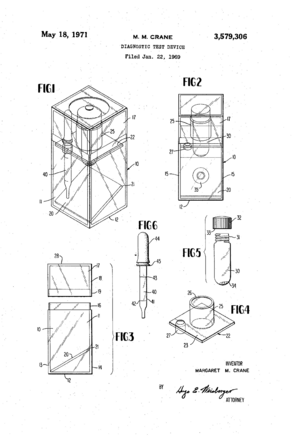Margaret Crane facts for kids
Quick facts for kids
Margaret M. Crane
|
|
|---|---|
| Nationality | American |
| Known for | Invention of the at-home pregnancy test |
| Scientific career | |
| Fields | Graphic design, product design |
Margaret M. Crane, also known as Meg Crane, is an American inventor and graphic designer. She is famous for creating the very first at-home pregnancy test in 1967. She developed this important invention while working for a company called Organon Pharmaceuticals in New Jersey.
Even though she invented it in 1967, the at-home pregnancy test wasn't available for people to buy until 1977. This was because some people thought doctors should be the only ones to give pregnancy tests. However, a test version was tried out in Canada in 1972.
Margaret Crane's Career
Margaret Crane was 26 years old when she started working at Organon in 1967. Her job was to help create a new line of beauty products. One day, while touring the company's lab, she saw many test tubes. She asked what they were for and learned they were pregnancy tests.
Each test tube contained special liquids called reagents. When mixed with a pregnant woman's urine, these liquids would show a red ring at the bottom of the test tube, indicating pregnancy.
Crane was inspired by this. She realized that women could easily do this test at home themselves. She believed it was important for women to have a quick and private way to find out if they were pregnant. Even though she didn't have a science background, she saw the need for this invention.
Her idea led to her first design for the at-home test. This design was eventually sold across the country starting in 1977. Later, Crane and her business partner, Ira Sturtevant, started their own advertising and design company called Ponzi & Weill.
How the Invention Happened
Margaret Crane decided to work on her idea at home in New York. She used simple items like a paper clip holder, a test tube, a mirror, and a dropper to create her first model. She put these parts together to make a prototype of the at-home pregnancy test.
When she showed her invention to Organon, the company was not sure about it at first. They worried that doctors might lose business if women could test themselves at home. However, Organon still applied for patents for her invention in 1969.
Eventually, Organon decided to try selling the product in a test market. Margaret Crane's design was chosen for this. Organon hired an advertising agency, and Ira Sturtevant was put in charge of the project. He was very impressed by how well Margaret Crane had designed the kit.
Organon chose Canada for the first test market. Crane and Sturtevant worked together on this project. They became business partners for over 40 years until Ira Sturtevant passed away in 2008. Their successful partnership led them to create their own marketing company, Ponzi and Weill.
This advertising company played a big part in promoting the pregnancy test. An early advertisement for the test said, "Every woman has the right to know whether or not she is pregnant." It also highlighted that women "can do by yourself, at home, in private, in minutes." This privacy and speed were Margaret Crane's main reasons for inventing the kit.
Before Crane's invention, women had to visit a doctor. Their urine would be sent to a lab, and they would often wait weeks for the results. In the 1960s, pregnancy tests worked by checking for a hormone called human chorionic gonadotropin (hCG) in urine. High levels of hCG meant a woman was pregnant.
Because of rules from the Food and Drug Administration (FDA) for medical devices, it took a while for Crane's prototype to be approved in the United States. The test finally received FDA approval in 1976. Soon after, in 1977, Margaret Crane's pregnancy test became available to the public. It was marketed under the name "The Predictor."
Even though her name was on the patents, Margaret Crane did not receive any money for her design. Organon licensed the product to other companies, and she had to sign away her rights for a very small amount of money. However, she was happy to have met her business partner, Ira Sturtevant, through the process.
It wasn't until 2012 that Margaret Crane received proper public recognition for her invention. The New York Times newspaper published an article about the history of pregnancy tests, but her name was not included. Crane realized she needed to speak up to get credit for her important contribution. She contacted the author of the article, and since then, she has been recognized for her pioneering work.
Legacy
In 2015, a prototype of "The Predictor" and a packaged version from 1970 were added to the collection of the Smithsonian’s National Museum of American History. This shows how important Margaret Crane's invention was to history.


